
Last night, the U.S. Air Force test-launched an unarmed Minuteman III ICBM from the Vandenberg Air Force Base. It’s not an event that happens every day, but it’s done to verify the reliability and accuracy of the weapons system. While it could be seen as a message to a belligerent North Korea, it’s still a test of a system wildly outdated compared to what Russia is arming up with.
The missile, equipped with a reentry vehicle, flew 4,200 miles to a test range near the Kwajalein Atoll in the Marshall Islands in the Pacific Ocean. It was pulled at random from a silo at Minot Air Force Base, in North Dakota, then transported and reassembled at Vandenberg.
There are no more details on how the test went. See the video below:
Though, given how North Korea recently announced that it is developing an ICBM that can reach the U.S. mainland, the Minuteman III launch may have just been a message to Pyongyang that Washington can strike it with little notice.
ADVERTISEMENT
The missile definitely wasn’t initially created with Kim Jong-un in mind.
Minuteman IIIs are the U.S. military’s only land-based ICBMs, which were designed during the 1950s and introduced in 1962 as counterattack deterrents against the Soviets if the Kremlin attacked first. It has an approximate range of 8,100 miles, a speed of more than 15,000 miles per hour, and can carry up to three warheads.
However, the Minuteman system is more than 50 years old, and Air Force officials have called for it to be replayed with a newer one. As the New Yorker explained in December, there is certainly a reason to replace them:
The Minuteman III is a relic of the Cold War not only in design but also in its strategic purpose. The locations of the silos, chosen more than half a century ago, make the missile useful only for striking targets inside Russia. The silos aren’t hardened enough to survive a nuclear detonation, and their coördinates are well known, so the Minuteman III is extremely vulnerable to attack. The President would be under great pressure, at the outset of a war with Russia, to “use them or lose them.”
The missiles now have two principal roles in America’s nuclear-war plans: they can be launched as part of a first strike, or they can be launched when early-warning satellites have determined that Russian warheads are heading toward the United States. After being launched, a Minuteman III cannot be remotely disabled, disarmed, or called back.
From the very beginning of the Minuteman program, the Air Force has successfully fought against adding a command-destruct mechanism, fearing that an adversary might somehow gain control of it and destroy all the missiles mid-flight. “Once they’re gone, they’re gone,” an Air Force officer told “60 Minutes” a few years ago.
Basically, the Minuteman IIIs are sitting ducks. Though, replacing them will also be tough, given today’s budgetary battles in Congress. President Obama ordered that the missile be operational through 2030.
ADVERTISEMENT
Meanwhile, Russia is replacing its Cold War-era RS-20B Voyevoda with the RS-28 Sarmat that will be operational by 2018. As the National Interest reports, the Sarmat will be a much more lethal ICBM than the Minuteman III:
The Sarmat will weigh at least 100-tons and carry a 10-ton payload. That means the missile could carry as many as 15 independently targeted thermo-nuclear warheads. It has a range of at least 6,000 miles. Once it is operational, it will be the largest ICBM ever built.
Like other modern Russian ICBMs such as the Yars, Topol-M and the Bulava, the Sarmat is being designed specifically to overcome ballistic missile defenses using a combination of decoys, a host of countermeasures and sheer speed. It might also be equipped with maneuvering warheads—which would make it much more difficult to intercept.
A little context here is important. Of course, U.S. military officials know the Minuteman III needs to be replaced and that the Russians are constantly modernizing its nuclear weapons arsenal. But the reasons why the Kremlin will get the Sarmat in service so quickly has much to do with how Russia and America’s governments run.
American presidents cannot single-handedly call for defense spending without approval of Congress. But in Russia, everything depends on what President Vladimir Putin wants. If he wants a weapons modernization, through hell or high water, he’s gonna get exactly that—or else. Putin’s party, United Russia, has consistently won supermajorities in the Duma, which means his MPs do not need support from other parties to pass legislation. In America, it’s tough to get Congress to pass budgets to even fix old-ass aircraft, as Foxtrot Alpha just reported this morning.
Comments
Post a Comment